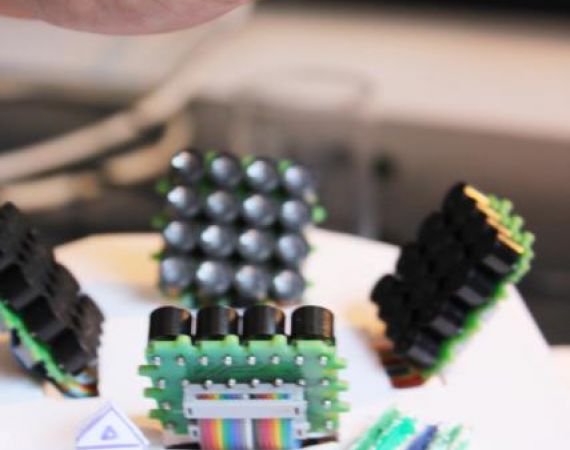Posted on Fri 10 Aug 2012
UltraHaptics Workshop: Write-Up
On the 24th July, the Pervasive Media Studio and the University of Bristol’s Interaction and Graphics Research Group (BIG) presented a two-

On the 24th July, the Pervasive Media Studio and the University of Bristol’s Interaction and Graphics Research Group (BIG) presented a two-day workshop to explore the potential applications of the new technology: UltraHaptics.
Bringing together a diverse group of creatives, technologists and programmers, the workshop tested the limitations of this still-in-development technology whilst also identifying how we might conceive to use it as it moves further along the development path.
While we are all used to the sensation of haptic feedback felt when using our phones or playing on games consoles (the resistance felt when hitting a tennis ball on the wii, or touch-sensitive vibrations on smartphones), the technology of the moment requires us to hold or touch a physical device in order to receive this sensation. However, the University of Bristol has developed the technology to be able to produce this feeling in mid-air. By emitting ultrasound waves through a series of transducers, the UltraHaptics devices are able to target the beams to a predefined point in the air allowing for the human skin to detect a point of resistance where the waves converge. The frequency of the ultrasound is all important, with the waves being emitted at a frequency of around 40 kHz (a frequency similar to that used by bats to communicate), just outside of hearing range but within the very narrow range of tactile sensitivity.
The workshop began by familiarising participants with the way in which haptic feedback technology can be used. There are currently 3 forms of haptic feedback:
• Proprioception: an awareness of the body and limbs
• Kinesthesia: an awareness of the body and limbs in space
• Tactile: a sense of touch felt by the body
Energised by possibility, participants set about brainstorming how future developments might allow us to use the technology. Ideas were varied and wide-ranging: from tactile sensations to imitate physical contact during virtual communications, to physical representations of phantom pains on prosthetic limbs. Despite the wealth of innovation coming from the participants, however, what became apparent was that every suggestion came with an over-arching question mark: would this actually be possible?
Part of the challenge with innovation is pushing technology to its limits, but what happens when we do not yet know where those limits lie? When the workshop moved on to explore the use of UltraHaptics, both participants and the Studio itself realised the difficulty of working with a new and relatively untested technology. In such an early stage of development, the UltraHaptics devices struggled to reach the strength or precision of points of resistance that participants required in order to achieve their ideas. As a result, the direction of the workshop shifted away from creating functioning devices and moved towards exploring future possibility.
With five groups applying the technology in five different manners, the University of Bristol researchers were able to obtain crucial feedback on the way in which these devices need to be developed. Requirements were not just that the transducers need to emit stronger beams to help increase tactile sensations, but that the digital interface of the devices needs to evolve away from java programming and towards a visual selection of sliders and buttons.
The workshop raised some interesting questions for the studio on how we interact with such early stage technologies. Our ethos is to get emerging technology into the hands of creatives as early as possible, to explore the potential for creative application and to give them a head start in designing for a new form. However, with technology that is as early stage as this, we need to be clearer about how we manage expectations and ensure there is value for all involved.
Thanks go to the members of BIG who assisted with proceedings over the course of the workshop: Tom Carter, Sue Ann Seah, Sriam Subramanian, David Coyle
And: Marianna Obrist (Newcastle University)